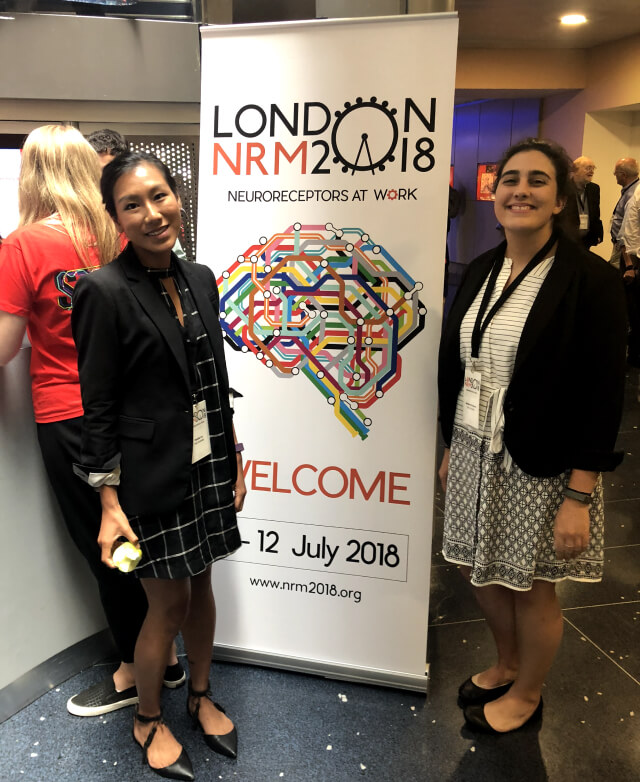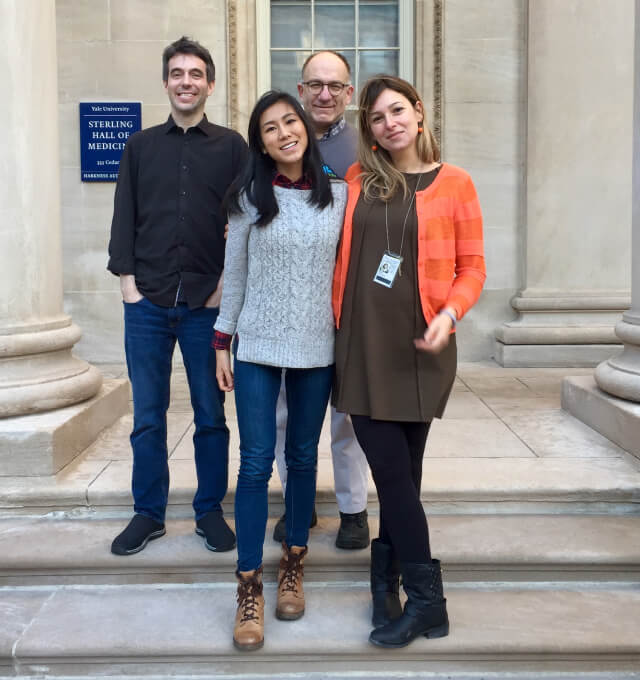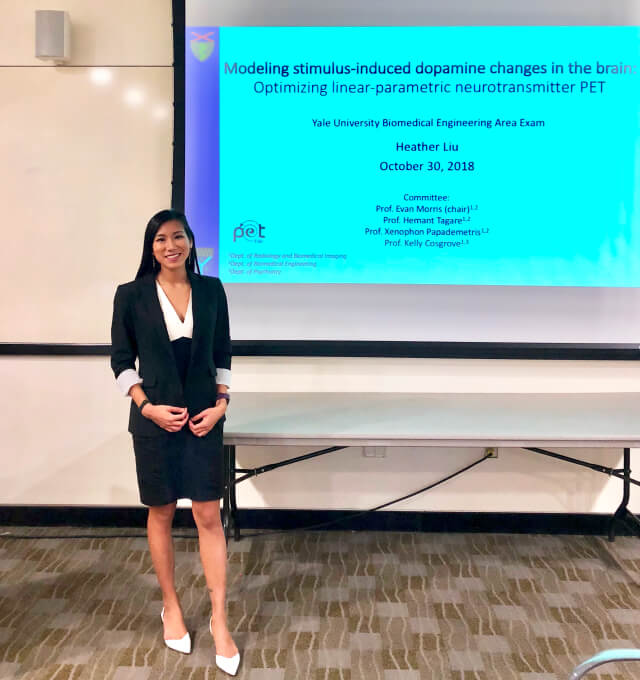I studied under Prof. Evan Morris in Yale's Engineering and Applied Science Dept. My PhD essentially asked:
What is the simplest, most computationally-efficient model to still draw useful information from complex (noisy, multidimensional) brain image data?
“Kinetic Modeling, Parameter Estimation and Model Comparison in Positron Emission Tomography: Functional Images of Neurotransmitter Dynamics and Drug Affinity”, aka “I modeled drugs in the brain from fancy imaging data”.
For the layperson,

I built algorithms for brain imaging data to understand how neurotransmitters, like dopamine, respond to stimuli, like drug-use or doing puzzles. I focused mainly on the mathematical modeling portion, trying to understand how statistics could be optimized in a complex and huge dataset. I collaborated with psychiatrists and neuroscientists to explore the connection between biology, behavior, and transient neurotransmitter patterns.
For the technically-inclined,

I worked on parameter estimation methods in linearized models of dynamical systems.The goal is to parse out transient neurotransmitter time-series from PET imaging data. This particular dynamical system describes the mass balance of radiotracers as they compete for binding with drugs or neurotransmitters at specific brain receptors. I experimented with basis function implementation and the resulting curiosity of non-integer degrees of freedom. I looked closely at model comparison metrics, i.e. the tradeoff between adding more parameters to a model and overfitting to noise.
For the biomedically-inclined,

I attempted to parse out the timing and amplitude of dopamine release in response to a temporary stimulus.I developed algorithms to fit 4D brain PET data (3D brain frames over the scan duration), which was collected as subjects partook in drug-use, cognitive tasks, acute stress, etc. I worked with some talented psychiatrists/neuroscientists to design brain imaging experiments to explore the relationship between biological factors, behavioral factors, and neurotransmitter signatures.









Publications
First-Author Publications
Liu, H., & Morris, E. D. (2021)
Detecting and classifying neurotransmitter signals from ultra-high sensitivity PET data: The future of molecular brain imaging.
Physics in medicine and biology, 66(17), 10.1088/1361-6560/ac195d.
Read the publicationLiu, H., & Morris, E. D. (2020)
Model Comparison Metrics Require Adaptive Correction if Parameters Are Discretized: Proof-of-Concept Applied to Transient Signals in Dynamic PET.
IEEE transactions on medical imaging, 39(7), 2451–2460.
Read the publicationLiu, H.*, de Laat, B.*, Hoye, J.*, & Morris, E. D. (2022)
EC50 images, a novel endpoint from PET target occupancy studies, reveal spatial variation in apparent drug affinity.
European journal of nuclear medicine and molecular imaging, 49(4), 1232–1241.
Read the publicationLiu, H.*, Zakiniaeiz, Y.*, Gao, H., Najafzadeh, S., Ropchan, J., Nabulsi, N., Huang, Y., Matuskey, D., Chen, M. K., Cosgrove, K. P., & Morris, E. D. (2022)
Nicotine Patch Alters Patterns of Cigarette Smoking-Induced Dopamine Release: Patterns Relate to Biomarkers Associated With Treatment Response.
Nicotine & tobacco research : official journal of the Society for Research on Nicotine and Tobacco, 24(10), 1597–1606.
Read the publicationLiu, H., Zakiniaeiz, Y., Cosgrove, K. P., & Morris, E. D. (2019)
Toward whole-brain dopamine movies: a critical review of PET imaging of dopamine transmission in the striatum and cortex.
Brain imaging and behavior, 13(2), 314–322.
Read the publicationOther Selected Publications
Calakos, K. C., Liu, H., Lu, Y., Anderson, J. M., Matuskey, D., Nabulsi, N., Ye, Y., Skosnik, P. D., D'Souza, D. C., Morris, E. D., Cosgrove, K. P., & Hillmer, A. T. (2021)
Assessment of transient dopamine responses to smoked cannabis.
Drug and alcohol dependence, 227, 108920.
Read the publicationSmart, K., Liu, H., Matuskey, D., Chen, M. K., Torres, K., Nabulsi, N., Labaree, D., Ropchan, J., Hillmer, A. T., Huang, Y., & Carson, R. E. (2021).
Binding of the synaptic vesicle radiotracer [11C]UCB-J is unchanged during functional brain activation using a visual stimulation task.
Journal of cerebral blood flow and metabolism : official journal of the International Society of Cerebral Blood Flow and Metabolism, 41(5), 1067–1079.
Read the publicationGroman, S. M., Hillmer, A. T., Liu, H., Fowles, K., Holden, D., Morris, E. D., Lee, D., & Taylor, J. R. (2020).
Midbrain D3 Receptor Availability Predicts Escalation in Cocaine Self-administration.
Biological psychiatry, 88(10), 767–776.
Read the publicationGroman, S. M., Hillmer, A. T., Liu, H., Fowles, K., Holden, D., Morris, E. D., Lee, D., & Taylor, J. R. (2020).
Dysregulation of Decision Making Related to Metabotropic Glutamate 5, but Not Midbrain D3, Receptor Availability Following Cocaine Self-administration in Rats.
Biological psychiatry, 88(10), 777–787.
Read the publicationHu, F., Morhard, R., Liu, H., Murphy, H., Farsiu, S., Ramanujam, N. (2016)
Label-free vascular imaging in a spontaneous hamster cheek pouch carcinogen model for pre-cancer detection.
970313.
Read the publication


